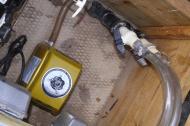- Information
- Products
- Pond Construction
- Koi Info
- Pond Info
- Portfolio
- Portfolio Introduction
- Portfolio I
- Portfolio II
- Portfolio III
- Portfolio IV
- Portfolio V
- Portfolio VI
- Portfolio VII
- Porfolio VIII
- Porfolio IX
- Portfolio X
- Porfolio XI
- Porfolio XII
- Portfolio XIII
- Porfolio XIV
- Portfolio XV
- Portfolio XVI
- Portfolio XVII
- Portfolio XVIII
- Portfolio XIX
- Portfolio XX
- Portfolio XXI
- Interest
pond aeration
Aeration is pivotal to the success of your pond. One could argue more important than filtration because fish will succumb faster without oxygen then they will in water with high ammonia or nitrite levels
The ultimate success of your filter is based on adequate oxygen levels in the water. The filters aerobic bacteriaare organisms that require oxygen to survive. They may even congregate in areas of high oxygen content require oxygen to carry out the Nitrogen Cycle effectively. In a fish pond, just having a waterfall will likely not be enough to keep the water at peak oxygen saturation points at all times, a backup aeration system needs to be in place
The ultimate success of your filter is based on adequate oxygen levels in the water. The filters aerobic bacteriaare organisms that require oxygen to survive. They may even congregate in areas of high oxygen content require oxygen to carry out the Nitrogen Cycle effectively. In a fish pond, just having a waterfall will likely not be enough to keep the water at peak oxygen saturation points at all times, a backup aeration system needs to be in place
How Water is Aerated
There are 2 main ways of getting O2 into the water. Water to air contact is one, the other is oxygenating plants. A given area of pond surface will absorb a certain amount of oxygen based upon air pressure, temperature and other factors [ie surface tension, other gases etc.]A waterfall will encourage oxygen into the water by not only the splash, but also by the waves created throughout the pond which increase its total surface area by up to 3 to 4 times. In addition, plants will also release oxygen into the water as a byproduct of photosynthesis. In simple terms these primary producers absorb CO2 and output O2. There is a major caveat however. because plants can't be relied upon to oxygenate your pond 24/7 as they they consume oxygen at night . So the irony of "oxygenating plants" [really a misnomer] is that if you have a lot, it's even more important to have a good aeration system in place in order to counteract their oxygen consumption during nightfall

By providing optimum aeration levels, the environment for your koi is one that will allow for good health and growth. It also creates currents which mix the water and exercise the fish. Additionally, it discourages algae by expelling carbon dioxide and preventing stagnation. Surface tension is also dramatically reduced and waves created thereby facilitating the absorption of oxygen through greater surface to air contact
The bottom line is that aeration, along with a good filter system, are both equally integral in providing a excellent environment for your fish. Never run your pond, even if it is houses a few goldfish, without an air system - besides all the benefits it is a great backup to your pond when your pump fails
Equipment for Aeration
All serious Koi keepers have a dedicated aeration system running in their ponds and often in the bio chambers of their filters. There are basically 4 methods to aerate, each with their advantages and disadvantages
Aquarium Air Pump
You should always have one of these on hand, especially a battery operated unit which can work during power failures or if you are on the road. They are inexpensive, good for small ponds and great in emergencies. They have limited air output Air Compressor
These units are a worthwhile investment. They put out quite a bit of air with good pressure which means they can be used for deep water aeration [a bottom drain for example]. Most are diaphragm driven so eventually the rubber membrane stretches / splits - reducing effective aeration depth. Diaphragms should be changed at least every 2 years or when a reduction in output is notedAir Blower
Blowers provide the most volume of air and are great for aerating a lot of tanks. The downside is that they are expensive and can't pump to the depths that compressors can. Mechanically, airblowers by design will last longer than diaphragm compressors as they utilize a big vane to move airVenturi
Venturis are probably the most efficient form of aeration. They operate off of your existing pumps return utilizing a physics trick in which air is drawn in through an airline by the restriction of flowing water. [the venturi principle]. They are inexpensive and great to augment / backup your main aeration systemRemember, you still need to have a separate aeration system because when your pump fails, the venturi will cease functioning. Operational depth is limited by pump flow rate and restriction size


